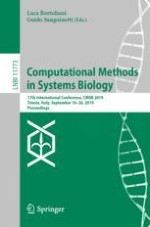2019 | OriginalPaper | Chapter
Fast Enumeration of Non-isomorphic Chemical Reaction Networks
Authors : Carlo Spaccasassi, Boyan Yordanov, Andrew Phillips, Neil Dalchau
Published in: Computational Methods in Systems Biology
Publisher: Springer International Publishing
Activate our intelligent search to find suitable subject content or patents.
Select sections of text to find matching patents with Artificial Intelligence. powered by
Select sections of text to find additional relevant content using AI-assisted search. powered by
Abstract
 . The problem of enumerating non-isomorphic CRNs can then be tackled by leveraging well-established computational methods from graph theory [20]. In particular, we extend Nauty, the graph isomorphism tool suite by McKay [22]. Our method is highly parallelisable and more efficient than competing approaches, and a software package (
. The problem of enumerating non-isomorphic CRNs can then be tackled by leveraging well-established computational methods from graph theory [20]. In particular, we extend Nauty, the graph isomorphism tool suite by McKay [22]. Our method is highly parallelisable and more efficient than competing approaches, and a software package (genCRN) is freely available for reuse. Non-isomorphs are generated directly by genCRN, alleviating the need to store intermediate results. We provide the first complete count of all 2-species bimolecular CRNs and extend previous known counts for classes of CRNs of special interest, such as mass-conserving and reversible CRNs.